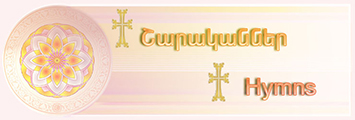Help
Welcome to https://arak29.org/sharakan-site, a site dedicated to Armenian sacred music. The site presents the 75 most common Armenian hymns from the badarak (divine liturgy or mass), daily offices, and special feast-day and holiday services. The site is designed for those who want to learn the sharakans, use them in church services or Sunday school classes, or private study and devotions. We draw your attention to the following features:
Site Layout
The Screen is divided into three panes:
Left - The Table of Contents
Middle - Main Text Window
Right - Annotations Window
The pane sizes can be adjusted by clicking on the frame and dragging it left or right to make the pane larger or smaller. When hymns are open, at the bottom of the Main Text Window, there are three icons – Search, Notes and Audio, which permit you to search and concordance the selected word in the hymn in the entire collection of sharakans, view the musical notation, and listen to an instrumental rendition of the melody of the hymn.
At the top of the window, the main menu items provide utilities and useful background to assist in understanding the sharakans and their place in the liturgical life of the Armenian Church.
1. Liturgical Calendar – This calendar presents the main feasts and holidays of the Armenian Church, along with explanations of those feasts and the calendar. By clicking on the feast day, you can view an explanation of the feast and related feast days. You can also view the calendar for different years from 2001 through 2024.
2. Dictionary & Concordance – This three-way dictionary can be arranged by Armenian, English or Translation headwords. If you want to view the word in context, select the word and click on the Search button at the top of the window. The concordance results are displayed in the Annotations Window at the right of your screen.
3. Introduction – This short explanation of origin, modes, daily offices, and types of sharakans aims to give a general understanding of Armenian sacred music as well as assist with some of the technical terms used in the annotations.
4. Chronology – This section presents chronological charts of the sharakans and their authors.
The main content features of this site are as follows:
a) Bilingual Interface – You can change the interface language by selecting the English or Armenian language buttons on the top left.
b) Table of Contents – For convenience in locating and browsing sharakans, there are three tables of content – by feast, by author and alphabetically. When you click on the feast or author, the main window gives a short description or biography.
c) Hymn Texts – In the main window, the texts of the hymns are presented in the original Classical Armenian, English Translation and Transliteration (Eastern pronunciation), which you can select by clicking on the tabs at the top of the Main Window.
d) Word-by-Word Translations and Concordance – To view the word-by-word translation of Classical Armenian text, with translation, transliteration and dictionary form, click on the word in the middle window. By clicking on Search Icon (binoculars) at the bottom of the middle window, you can view a concordance for that word in all of the sharakans in the Annotations Window.
e) Musical Notation and Melody – If you wish to hear the melody or see the musical notation for the sharakan, click on the Notes Icon or Audio icon at the bottom of the Main Window. The Notes are provided in ready-to-print PDF format, including word-by-word translations and full-text English translations of the hymn text.
Troubleshooting:
Fonts – The entire site is in Unicode. If you are using Windows 2000, XP or higher and have done a complete installation of the windows software including regional language support, your browser should automatically display Armenian and include Armenian keyboard support.
If Armenian letters are not displayed, try the following troubleshooting tips:
1. Check the Regional & Language Settings in your Control Panel (accessible through the Start Menu on the lower left corner of your screen). On the Language Tab, make sure that the “Install complex scripts option (including Thai)” is checked. If you select it and the necessary files were not installed when you did your initial Windows installation, you will be prompted to insert your Windows system disk to install the missing language support components.
2. Check your Browser's Internet Options under the Tools menu for Internet Explorer. Click on the Languages button and add Armenian if it is not already listed on the languages list. Click on the Fonts button and check to make sure you don't have a conflicting font selection. Common default settings that are compatible with displaying Armenian are Latin-based, New Times Roman and Courier New.
3. Check your Brower's Encoding Setting, located under the View Menu in Internet Explorer. Common default settings which are compatible with displaying Armenian are Auto-select, UTF-8 (Left-to-right).
Audio Problems – If you do not hear music, check to make sure you do not have a hardware problem (e.g., speakers plugged in properly, manual volume control), software problem (mute selected or volume too low), or no media/audio player plug-in program.
Musical Notation – The Acrobat reader plug-in must be installed to view and print the music notation files. Adobe Acrobat reader plug-ins are usually standard with newer browsers and systems. If you need this plug-in or need an upgrade, it can be downloaded free from http://www.adobe.com/products/acrobat/readstep2.html.
Keyboard Problems – The dictionary permits keyboard entry for look-ups. Since the entire site is in Unicode you should make sure that you are entering Armenian using a Unicode format keyboard. If you do not see Armenian letters in the text entry box when you try to type Armenian, but there is Armenian elsewhere on the screen, you probably are not using a Unicode keyboard format. Change the keyboard to a Unicode compatible keyboard setting and the Armenian letters should be displayed properly when you type.
